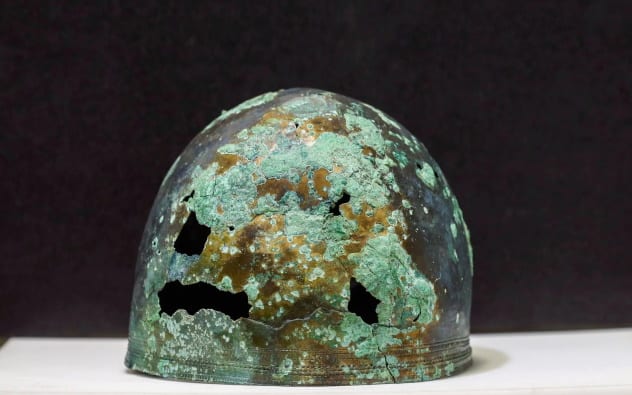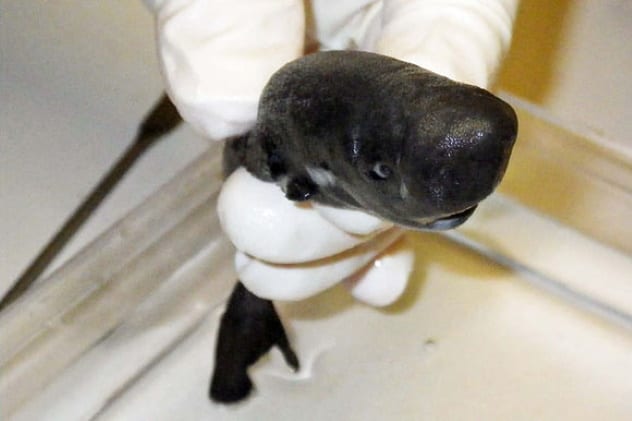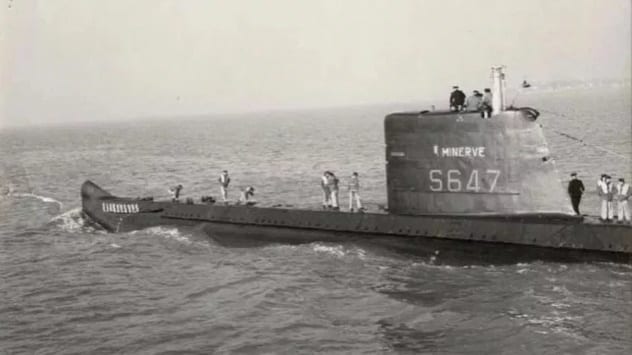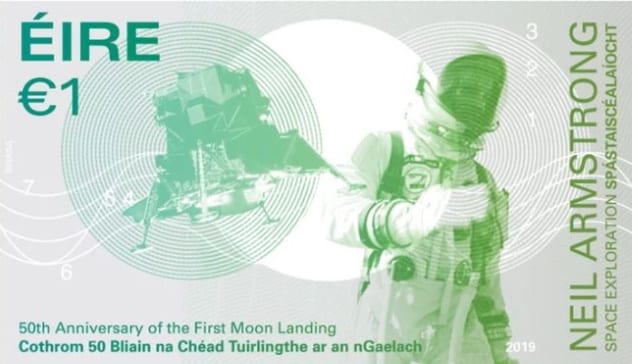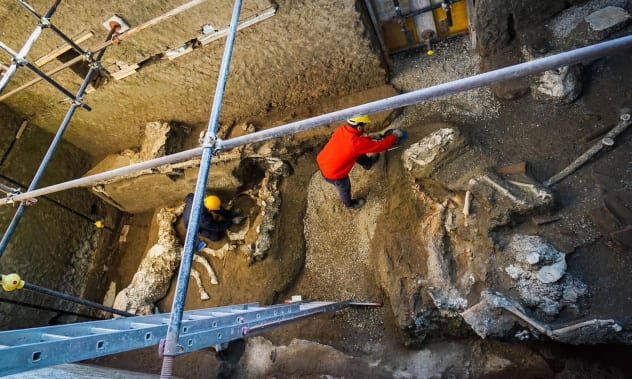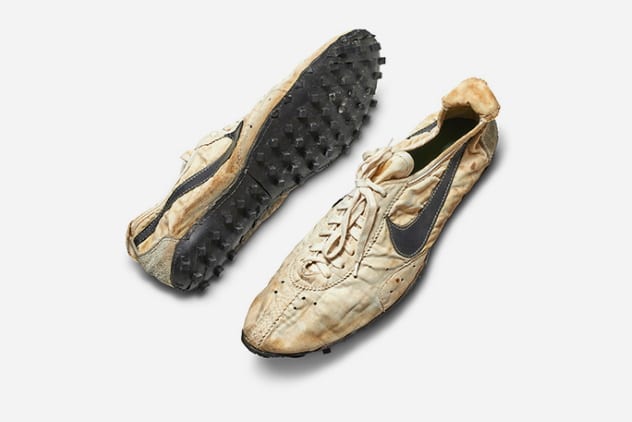We look at a couple of interesting rivalries this week, one over which state has more lakes and the other over research rights at Pompeii. We also answer a few lingering questions, such as “What happened to the submarine Minerve?” and “Where are all the paintings by Bob Ross?” There is also talk of an 800-year-old tradition and the most expensive sneakers in the world.
10 Asterix In Britain
After a decade of study, the artifacts belonging to an ancient warrior dubbed a “real-life Asterix” are ready to go on display for the first time. English archaeologists announced the discovery made in West Sussex as being “the most elaborately equipped warrior grave ever found in England.”[1] Although we don’t know his name, the Iron Age soldier fought with the Gauls against Caesar, just like his comic book counterpart. He was either a Gaul himself who later fled to Britain or, alternatively, someone born in Eastern England who crossed the channel to help the Gauls in their fight against the Romans. His grave was first located in 2008 during excavations for a new housing project. However, it took scholars all this time to carefully conserve and analyze everything that was inside. Highlights include a bent sword, most of an intricate, ornate headdress, and a helmet with Celtic openwork crests that is “absolutely unique.” They will go on display at the Novium Museum in Chichester in January 2020.
9 Where Are All The Happy Little Accidents?
Bob Ross might be one of the most prolific American painters of all time. He was responsible for an estimated 30,000 paintings during his lifetime, 1,143 of which he did for his PBS show The Joy of Painting. And yet you almost never see one. That led The New York Times to wonder where exactly all these artworks are, so they launched an investigation to find out. The answer is Herndon, Virginia.[2] This is because Herndon is the home of Bob Ross Inc., still run by his longtime business partner Annette Kowalski. Almost all of his paintings are stored carefully in a warehouse, but they are not for sale. In fact, the idea never even occurred to the Kowalskis because it would defeat the purpose that Bob Ross had as an artist. Instead of selling himself, he sold the idea that anybody could be an artist with a little practice and the willingness to make some happy little accidents. That being said, the company recently donated some paintings to the Smithsonian National Museum of American History. There were four of them, including three versions of the same painting titled On A Clear Day. Bob Ross actually made three renditions of a painting for each episode of his television show. The first served as an initial reference, the second was the one you saw on TV, and the third was a more in-depth version he included in his books.
8 Glow-In-The-Dark Shark
Researchers from Tulane University and the National Oceanic and Atmospheric Administration (NOAA) have identified a new species of shark with an interesting characteristic: It glows in the dark. The diminutive shark is only 14 centimeters (5.5 in) long and comes from the Gulf of Mexico. Scientists initially spotted it in 2010 during an unrelated study on sperm whales. It remained a mystery until 2013, when it was again discovered by a NOAA researcher. Now, the animal has been described as an entirely new species called the American pocket shark. Its name is derived from the fact that it has a pocket gland near its front fins which secrets a bioluminescent fluid.[3] This is only the second specimen of pocket shark ever captured or recorded. The first one was found in the Pacific Ocean in 1979. They are different species that live in different oceans and, evidently, are incredibly rare. Scientists speculate that the shark uses its bioluminescent ability to attract prey, but we simply don’t know enough about this abstruse species to say anything with certainty.
7 Minerve Located
On January 27, 1968, the French submarine Minerve disappeared while on its way to the naval base at Toulon, taking with it its entire crew of 52. Its fate remained a mystery for over five decades, until the wreck was finally found last week. When Minerve vanished, French authorities launched several search and rescue missions, including one supervised by explorer and conservationist Jacques Cousteau. Alas, no trace of the vessel was found, and the search was called off in February. This July, the government renewed its efforts to find the submarine, following added pressure from the families of the crew members. This time, it had the advantage of modern technology and high-tech equipment, and the search paid off. First located by private US company Ocean Infinity, Minerve was discovered 45 kilometers (27 mi) from Toulon, at a depth of 2,370 meters (7,775 ft).[4] Underwater drones first spotted the wreck in low sedimentation and observed the first three letters of the vessel’s name to confirm its identity. Examining the submarine might tell us why it sank in the first place. The captain of the boat, Lieutenant Andre Fauve, had thousands of hours experience on similar vessels, so human error was never considered a likely possibility. Some believe that extremely bad weather was to blame, while others opine that rudder problems caused the sub to sink and implode.
6 Getting Rich Off Snail Mucus
There is a new booming industry in Thailand: “milking” snails. The secretion of these mollusks has become a must-have ingredient in cosmetics, particularly in Korea and the United States. As just one face cream can cost hundreds of dollars, in just three years, the Thai snail “milking” industry has become worth an estimated $314 million. To call the process “milking” is a delicate and positive misnomer. The substance is a slime called mucin, and there is no milking involved. The procedure is actually safe for the mollusks. It simply requires dripping some water over them, which encourages their glands to produce mucin. Not only that, but to keep them in good health and maintain the quality of the secretion, the snails are fed on grains and vegetables and only “milked” once every three weeks.[5] The Thai farmers benefit from the industry, as well. Before, they saw the snails as pests who damaged their crops. They would collect them and throw them in rivers. Now, they sell them for a profit.
5 Wisconsin vs. Minnesota
Over the past few months, there has been an ongoing rivalry between frenemy states Wisconsin and Minnesota over who has more lakes. Minnesota prides itself as the “Land of 10,000 Lakes.” However, in May, new Wisconsin tourism secretary Sara Meaney took the opportunity during a radio interview to specify that her state has 15,000 freshwater lakes. Technically, she was right. Her state’s Department of Natural Resources (DNR) lists 15,074 documented lakes, while the Minnesota DNR only lists 11,482. However, as many Minnesotans were quick to point out, the two states have different criteria for what they consider a lake. There is no official definition for it. Therefore, Minnesota considers a lake any body of water with a surface area over 10 acres. Wisconsin, however, counts everything from a half-acre pond and up.[6] Using any kind of equal criteria would give the win to Minnesota. A spokesman for the Wisconsin Department of Tourism didn’t back down and, instead, took the opportunity to brag about his state’s football superiority, another hot-button issue between the two rivals. He agreed that they get two different numbers because they can’t agree over the definition of a lake. He then invited Minnesota to count its lakes alongside its Super Bowl rings, of which they have zero while Wisconsin has four.
4 The First Landing On The Irish
With the 50th anniversary of the Moon landing having recently passed, what better time for Ireland to release new commemorative stamps honoring astronauts with Irish ancestry? The stamps have text in English and Irish, but a pretty big slip-up sneaked through on the Irish side: it misspelled the word “Moon.” In English, the stamps simply say “50th Anniversary of the First Moon Landing.” The Irish version is supposed to say the same thing, but it has the word Gaelach instead of Gealach.[7] While the latter means “Moon,” the former refers to something Gaelic or Irish. Therefore, the stamps now celebrate the “50th Anniversary of the First Landing on the Irish.” The state-owned postal service An Post was responsible for the blunder, and they blamed a transposition error that wasn’t caught before the stamps were sent for printing.
3 Who Can Study Pompeii?
There is a row going on between two scientific factions over who has better access to the ruins of Pompeii. Volcanologists claim that they are being ousted by archaeologists who are not only hogging the best sites but are also destroying volcanic deposits to discover artifacts. In 2012, the Italian government launched the Great Pompeii Project, a large-scale effort to preserve the site ravaged by the eruption of Mount Vesuvius 2,000 years ago. Since then, archaeologists have made numerous new discoveries about the everyday life of the citizens of Pompeii as they chip away layer after layer of rock. Volcanologists, however, want to study those rocks. Vesuvius is one of the most dangerous volcanoes on the planet. Not only do experts believe it will erupt again one day, but it also has millions of people in its vicinity. Several Earth scientists have published an open letter in Nature, criticizing their fellow researchers for destroying volcanic deposits at an alarming rate. Roberto Scandone, a professor of volcanology at the Roma Tre University, accuses them of committing “an act of vandalism to volcanology.”[8] Earth scientists also bemoan the fact that certain areas have been restricted to them for “health and safety reasons.” A spokeswoman for the Archaeological Park of Pompeii downplayed the rivalry, saying that the two sides are studying the site jointly according to an agreement settled years ago. Archaeologists argue that Pompeii is large enough and that there is plenty of rock to analyze beyond the point of the main city area.
2 Changing An Ancient Tradition
Karen Hammond from South Dakota has become the first woman to take part in an English tradition that dates back to the 12th century. She served as a royal swan upper. Swan upping is a ceremony that takes place every year in the third week of July. It involves counting the swans on the River Thames, which, according to a distant decree, belong to the Queen. Back in the old days, this was in order for the Crown to know how many birds there were to eat. Now, it is more about upholding an 800-year-old tradition, but it also helps conservationists by letting them know how many baby swans are born each year. The birds are also ringed and get a quick health check. The counting is done by a flotilla of six wooden skiffs. For centuries, these have been filled by all-male rowing teams, but that changed this year when Karen Hammond joined the count as a swan upper.[9] She is friends with David Barber, who holds the position of official queen’s swan marker. He thought that Karen’s passion for wildlife and rowing made her an ideal candidate for the job.
1 Just Buy It
A pair of Nike shoes set a new record for most expensive sneakers sold at auction after going for $437,500. The buyer is Canadian businessman Miles Nadal. The sneakers in question are a handmade pair of 1972 Nike Waffle Racing Flats, better known as “Moon Shoes.”[10] They were designed by Nike co-founder and legendary track and field coach Bill Bowerman. Initially intended for the runners at the 1972 Olympic Trials, only 12 pairs were made, and these were the only ones known to have never been worn. Back when they first appeared, people thought the unique sole pattern left an imprint on the ground similar to that of astronaut suits, which is why they were called “Moon Shoes.” The footwear was sold by Sotheby’s as part of “The Ultimate Sneaker Collection.” This unique pair came from Jordy Geller, the man with the largest collection of sneakers in the world, while 99 other pairs of shoes were provided by streetwear marketplace Stadium Goods. At first, all 100 pairs of sneakers were intended to be sold as a complete collection at a private auction. However, the “Moon Shoes” were considered rare and coveted enough that they would fetch the best price as a standalone item at a public auction. Miles Nadal spent $850,000 on the other 99 pairs and, afterward, bid another $437,500 to buy the “Moon Shoes” and secure the entire collection.
